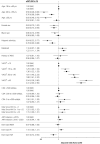Definition, Burden, and Predictors of HIV-Associated Wasting and Low Weight in the OPERA Cohort
- PMID: 37489298
- PMCID: PMC10712360
- DOI: 10.1089/AID.2023.0048
Definition, Burden, and Predictors of HIV-Associated Wasting and Low Weight in the OPERA Cohort
Abstract
We aimed to describe the prevalence, incidence, and predictors of HIV-associated wasting (HIVAW)/low weight among people with HIV (PWH) in the United States. We conducted an observational, clinical cohort analysis, utilizing prospectively collected electronic health record data obtained from the Observational Pharmaco-Epidemiology Research & Analysis (OPERA®) cohort. HIVAW/low weight included a wasting or low body-mass index (BMI)/underweight diagnosis (ICD codes and title search) or BMI <20 kg/m2. Prevalence was estimated among adult PWH in care from 2012 to 2015 and 2016 to 2020. Incidence from January 1, 2016, to October 31, 2021, was estimated using univariate Poisson regression among eligible PWH without prior HIVAW/low weight. Demographic and clinical predictors of incident HIVAW/low weight were included in multivariable logistic regression models, stratified by antiretroviral therapy (ART) experience. The period prevalence of HIVAW/low weight was 12% in both 2012-2015 and 2016-2020. Among 67,119 PWH without any prior HIVAW/low weight, 7% experienced incident HIVAW/low weight a median 64 months from HIV diagnosis. In multivariable regression models, similar predictor patterns were observed among ART-naïve and ART-experienced PWH without any prior HIVAW/low weight: lower odds of HIVAW/low weight with older age, female sex, Black race, and Hispanic ethnicity and higher odds with Medicaid. Notably, there was a dose-response relationship between increasing Veterans Aging Cohort Study Mortality Index scores and incident HIVAW/low weight in both groups. Wasting/low weight remains a challenge for PWH and may be underappreciated by providers. Advanced HIV and comorbidities significantly predict incident HIVAW/low weight. Increasing awareness of HIVAW, especially among frailer PWH, could improve the care of affected PWH.
Keywords: HIV wasting syndrome; comorbidity; incidence; prevalence; weight loss.
Conflict of interest statement
M.B.W. has participated in postconference advisory boards for the Conference on Retroviruses and Opportunistic Infections (CROI) and International AIDS Conference (IAC) and serves as a principal investigator on ViiV Healthcare clinical trials, but does not receive personal compensation for this work, which goes directly to the AIDS Healthcare Foundation. M.B.W. is also a member of the Epidemiology and Clinical Advisory Board for Epividian, Inc. R.P.W., L.B., J.S.F., and G.P.F. are employed by Epividian, Inc.; Epividian has had research funded by the AIDS Healthcare Foundation, EMD Serono, Gilead Sciences, Janssen, Merck & Co., Theratechnologies, Inc., and ViiV Healthcare. J.S. is a consultant for Merck & Co., AbbVie, and Shionogi. M.H., A.L.P., and B.H. were employed by EMD Serono at the time of this analysis. R.K.H. has received a research grant from Gilead Sciences; received speaker honoraria and served on advisory boards for ViiV Healthcare, Bristol Myers Squibb, Merck & Co., Gilead Sciences, and Janssen; and is a member of the Epidemiology and Clinical Advisory Board for Epividian, Inc.
Figures

References
-
- Centers for Disease Control (CDC). Revision of the CDC surveillance case definition for acquired immunodeficiency syndrome. Council of State and Territorial Epidemiologists; AIDS Program, Center for Infectious Diseases. MMWR Suppl 1987;36(1):1s–15s. - PubMed
-
- Hellerstein MK, Kahn J, Mudie H, et al. . Current approach to the treatment of human immunodeficiency virus-associated weight loss: Pathophysiologic considerations and emerging management strategies. Semin Oncol 1990;17(6 Suppl 9):17–33 - PubMed
Publication types
MeSH terms
LinkOut - more resources
Full Text Sources
Medical
